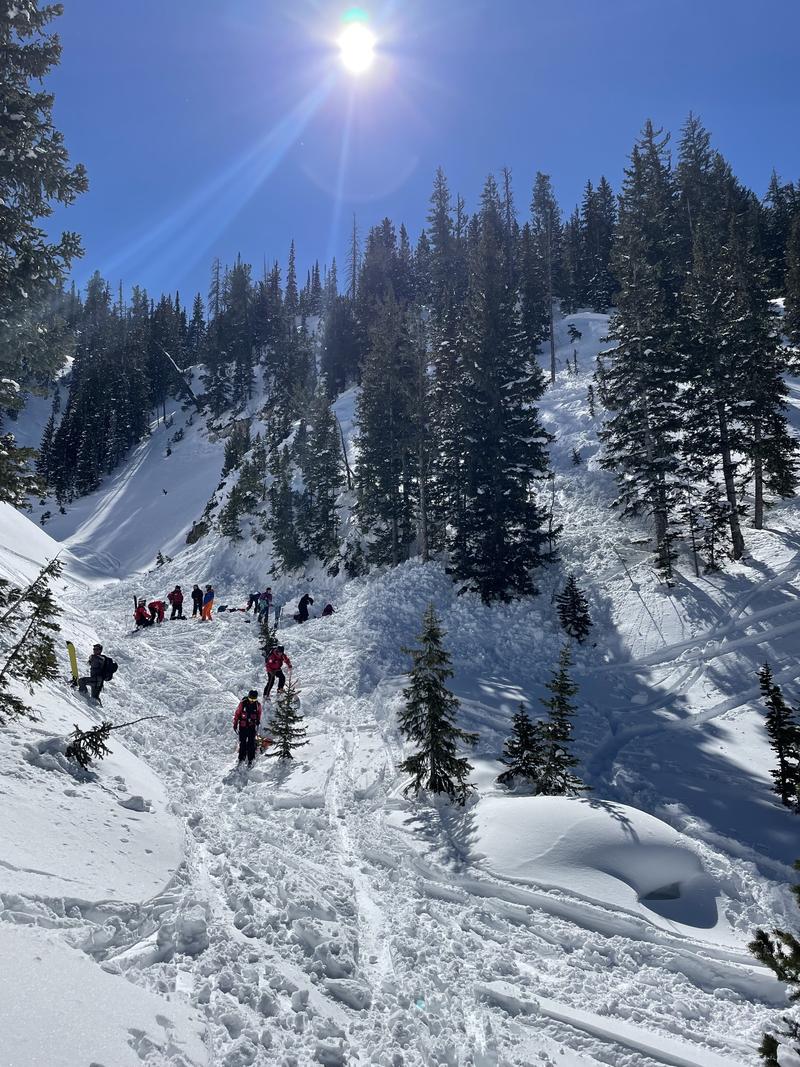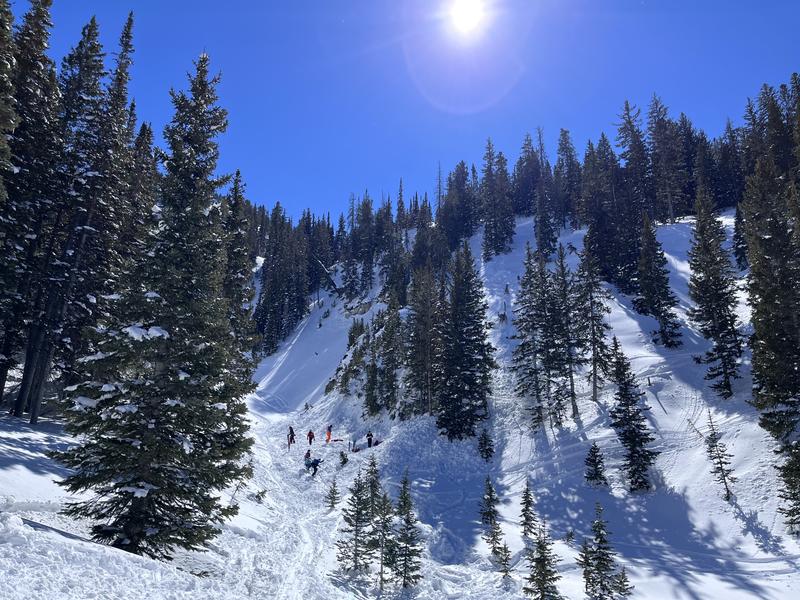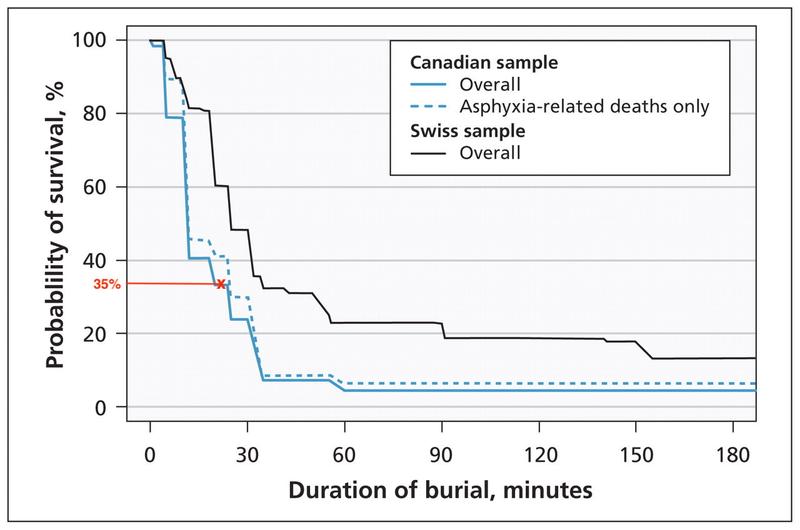Observer Name
UAC Staff
Observation Date
Saturday, March 12, 2022
Avalanche Date
Saturday, March 12, 2022
Region
Salt Lake » Big Cottonwood Canyon » Silver Fork
Location Name or Route
Upper Silverfork
Elevation
9,400'
Aspect
Northeast
Slope Angle
38°
Trigger
Skier
Trigger: additional info
Unintentionally Triggered
Avalanche Type
Soft Slab
Avalanche Problem
Persistent Weak Layer
Weak Layer
Facets
Depth
21"
Width
70'
Vertical
250'
Caught
1
Carried
1
Buried - Fully
1
Injured
1
Accident and Rescue Summary
A guided party of 6, with two guides, ascended from Grizzly Gulch in Little Cottonwood Canyon towards East Bowl Pass overlooking Silver Fork. While traveling, the group separated into group A and group B and planned to regroup on the benches below Silver Fork's West Bowl. Group A consisted of four clients, and one guide, moving at a bit faster pace. Group B consisted of two clients, and one guide.
Group A ascended to the top of East Bowl. Group A ascended to East Peak and safely descended the lower angle terrain and waited for Group B on a bench below West Bowl. Group B arrived East Bowl Pass and headed up Davenport Hill to ski Cabin Ridgeline into Silver Fork.
Group B descended Cabin Ridgeline one at a time in pitches. On the final ski pitch to join Group A, the first skier safely descended the pitch. While the second skier was midway down the pitch, an avalanche released above them. The party below yelled "Avalanche!" and the skier was able to ski off the slope and away from the avalanche. The guide at the top of the pitch, however, was caught, carried, and fully buried in the gully.
At approx 1230, one of the party members called 911 and the group booted toward the debris pile to recover the fully buried skier.
After a beacon search and positive probe strike, they extracted the skier and cleared his airway. The victim was buried 6' deep. It took 23 minutes from the time the avalanche was initially triggered to the time that the airway was cleared. The skier was breathing and had a pulse when the airway was cleared. Having been strained through trees in the avalanche, the victim lost both poles, one ski, and their helmet. He experience trauma on the left side of his face and body.
Five minutes after the buried skier was recovered, Solitude ski patrol arrived on the scene. In partnership with WBR/Snowbird/Powderbirds, the skier was hoisted out by Lifeflight around 1430, the skier was critical but stable. The remaining party members skied out with Solitude ski patrol.
Photos from A. Kopko & Ski Party






Weather Conditions and History
The danger roses for the Salt Lake mountains from Friday, March 4 through Thursday, March 10.

Summary: The storminess week since December! Several human-triggered avalanches with a few near-misses. Most avalanche activities involved the weak layer of faceted snow from the January-February drought.
Unsettled weather began for most of Utah Saturday, March 5th with elevated south/southwest winds and 2-6" of snow by the end of the day. During this first system, avalanche activity was limited to sluffing on steep, upper elevation northerly slopes and a few pockets of wind-drifted snow. This was the first sign of instabilities, and avalanches breaking on the January/February faceted layer.
The next significant snowfall began Tuesday, March 8th. An unstable northwest flow brought 6" by sunset and turned into an impressive storm overnight and into Wednesday.
Snowfall totals include:
Little Cottonwood Canyon 24-48" containing up to 2.6" snow water equivalent (SWE)
Big Cottonwood Canyon 14-44"" (up to 2.75" SWE)
Park City Ridgeline 12-16" (up to 1.2" SWE)
More widespread avalanche activity began occurring on the January/February faceted layer, including natural cycles. Following Wednesday and leading into the weekend, the weather cleared and skies become sunny into the weekend with some elevated winds and no significant snowfall.

Comments
Personal Account From Winslow Passey
The Preciousness of Life
March 13th, 2022
Yesterday I was involved in a rescue and I will tell the story here.
Willie and I were guiding 6 women, two of them had their Avalanche 1 training and one had her avalanche 2 training. We planned a bi-canyon tour so we dropped a car at the base of BCC and met at the swamp lot and took the bus up to Alta. We review the current conditions and avalanche hazards with them and looked a the photos of avalanches from the day before. We discussed the state of the snowpack, and we talked about what to do if there was an avalanche while at the bus stop.
At the trailhead, we did beacon range checks and headed up. On the way up we dug on two north-facing knolls to see the weak layer. At Chad's gap, 9300’ we dug a pit on NW facing. HS was 100cm, there was 40 cm of new snow (F-1F hardness) on top of Fist hardness facets (10cm) with 4 F facets below that. The facets were wet and I could make a snowball with them. I had no result on the Compression Test.
4 girls were faster so I took them up to East pass to assess the snowpack there. I popped just over the pass and probed. The snowpack was 320cm deep. I dug about a meter down and was nowhere near the weak layer as there was a lot of wind-blown snow there. The winds had been blowing upslope and depositing snow before making it over the ridge. It was not a sensitive slab in that spot. I decided that I could not accurately test the weak layer that was going to be only two feet deep further down the slope, so I decided not to ski the slope.
Willie arrived with the other two. I told him we were going to go up to East Peak, traverse down the NW ridge to the lower angle saddle, and skid into the east bowl from there. Willie said he thought his two needed a shorter hike, one had flown in the day before from sea level, and said that he was going up Davenport and would ski Cabin Ridgeline and meet me there.
We skied into an east bowl and got to the bottom where the skin track heads back up to the west bowl. We stopped on the bench absove the gully so as not to be in the gully. I had just taken off my skies and pulled out my skins when we heard the other party above us. Willie had them ski one at a time down to me. The first girl skied down to us with no incident. The second was halfway down the slope when it triggered. I yelled avalanche and told her to ski out of there. She cut to the side out of the path easily. Willie had yelled avalanche too. I thought he was at the top. I did not see him go down with the avalanche. I yelled for him and when he didn’t answer we knew he was buried.
I approximate the slide was a SS about 100’ long, 40’ wide, and 2’ deep. The slope angle was over 35.
I had one girl call 911, everyone turned to search, I and another gal booted over to the debris pile and began searching the other gals put on their skins in case that was faster as we did not know how high up he might be. The debris had gone through lots of trees. The debris was soft and deep. I was wallowing but made it up to him. The woman that had traversed out of the slide came over from above to help.
My heart sank when I saw that my lowest number was 1.6. I did a grid box at 1.8 in all 4 directions. Someone handed me a probe and the girls began clearing the snow below as I probed. We got a strike that was about 150cm down.
We dug like mad and first got to his boot. His boot was higher and his body went diagonally down and he was face down. It took a while to get him out. We next got to the pack and it was still a long way to get his face and airway out. We got an airway after 23 minutes. He had a pulse and was barely breathing. One woman held his face as we continued to dig out his buried arm and leg that were still deeper. It took a lot of work to get him onto his back. We all got in there and did a roll. He was unconscious but alive.
Shorter after the solitude ski patrol arrived and then several Wasatch powder bird guides.
Another backcountry party was skiing down a gully above us where the silver fork drainage takes a bend. They triggered a small slide there and though the debris did not come close to us, it highlighted the danger around us being in the gully.
We all worked together to get him on a sled and tried to warm him. He started to gain consciousness and was screaming in pain as he had some fractures ribs and nose and a busted eye. He was talking before we got to the LZ but he was cold.
It was about 2 hours from the incident to get him long-lined out by helicopter from a safe landing zone further down. The patrol did amazing dragging him out above the gully on the right-hand side. The landing zone was below the gully on a bench to the right looking down the canyon.
As I process the incident I keep feeling so grateful for the 6 women who dug so hard, for the patrollers and rescuers who helped, for Willie, for my family, for our community, and all of the people who reached out with love. I am grateful for solitude and their support and taking care of us afterward. And received the helicopter rescue.
It drives home to me how precious this life is, the breath of life in each moment is a gift. And I recognize the beauty of each person. We are all lucky to be alive here on this planet.
Check your slope angles carefully out there. I was using my cal topo slope angle shading all day today to find a safe way down. This snowpack is not to be trusted right now.
Additional takeaways from Winslow:
1. I carry a nasopharyngeal, which we used as we were unsure of his airway. We ended up taking it out, but I was glad to have it. It could save a life.
2. Make sure your “safe spot” is a safe spot.
Comments
Forecaster Notes:
A couple of things that went right for him, that could have very easily gone wrong:
-The amount of time the skier was buried under the snow surface before the airway was cleared. The skier was buried for 23 minutes. Below the 15 minute mark, the probability of survival drops rapidly. At the 23 minute mark the probability drops to 35%.

-The team being so close by. Since the skier was the third person on the slope, and Group A was at the bottom of the slope, in most situations the rescuers would have to transition back to uphill travel mode. Given the location of the burial and the location of Group A, they were able to begin a companion rescue via foot saving them valuable time.
As well, the two clients with Group B had less avalanche training than the members of Group A. So the close location of Group A allowed the more experienced members to run the rescue.
-Could have easily been a multi-burial. The second skier on the slope was able to ski out of the terrain, but at the time two skiers were within the avalanche path. So it could have easily become a multi-burial situation.
Video
Coordinates






